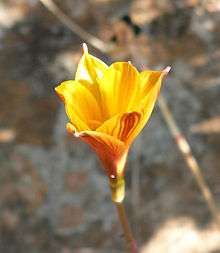Habranthus tubispathus
Habranthus tubispathus, the Rio Grande copperlily or Barbados snowdrop,[2] is a species of flowering plant in the family Amaryllidaceae. It is a perennial bulb native to southern South America (Brazil, Argentina, Paraguay and Uruguay). It is widely cultivated as an ornamental and reportedly naturalized in the southeastern United States (Texas, Louisiana, Alabama, Georgia, Florida), much of the West Indies as well as Bermuda, eastern Mexico, India, Easter Island, and central Chile.[3]
| Habranthus tubispathus | |
|---|---|
 | |
| Scientific classification | |
| Kingdom: | Plantae |
| Clade: | Tracheophytes |
| Clade: | Angiosperms |
| Clade: | Monocots |
| Order: | Asparagales |
| Family: | Amaryllidaceae |
| Subfamily: | Amaryllidoideae |
| Genus: | Habranthus |
| Species: | H. tubispathus |
| Binomial name | |
| Habranthus tubispathus (L'Hér.) Traub | |
| Synonyms[1] | |
| |
Description
Flowers are produced sporadically during late summer and autumn, singly on stems 10 to 20 centimetres (4 to 8 in) tall. Flowers are usually yellow with copper tones on the outside, with tepals about 3 centimetres (1.2 in) long, fused for a short distance at the base to form a tube. As with all Habranthus species, the flowers are not upright on the stem but held at a slight angle. The leaves are not normally present at flowering time, appearing later; they are narrowly linear.[3]
Cultivation
Habranthus tubispathus tolerates some frost down to 0 °C (32 °F) if planted in a sheltered sunny position, but will not survive being frozen. It seeds freely. A form with pinkish flowers is grown as H. tubispathus var. roseus, but may be a hybrid.[3]
H. tubispathus has gained the Royal Horticultural Society's Award of Garden Merit.[2][5] The synonym H. andersonii is commonly found in horticultural sources.
 Growing in Denton, Texas, USA
Growing in Denton, Texas, USA Growing in Denton, Texas, USA
Growing in Denton, Texas, USA Seeds
Seeds Growing at TWU in Denton, Tx.
Growing at TWU in Denton, Tx.
References
- World Checklist of Selected Plant Families, The Board of Trustees of the Royal Botanic Gardens, Kew, retrieved 2011-09-23, search for "Habranthus tubispathus"
- "RHS Plant Selector - Habranthus tubispathus". Retrieved 5 July 2020.
- Mathew, Brian (1987), The Smaller Bulbs, London: B.T. Batsford, ISBN 978-0-7134-4922-8, p. 101
- "Katoch D and Singh B, Med Aromat Plants" (PDF).
- "AGM Plants - Ornamental" (PDF). Royal Horticultural Society. July 2017. p. 44. Retrieved 3 March 2018.